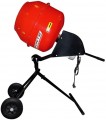Drum capacity
The total volume of the working drum of the cement mixer. The amount of solution that can be prepared in the device at a time directly depends on this parameter. Accordingly, it is worth choosing a model according to the volume of the drum depending on the scale of the proposed work — the more concrete is needed and the more people are involved in the process, the larger the cement mixer should be. At the same time, it does not always make sense to chase the maximum capacity — after all, such models are not only rather bulky and high consumption, but also expensive.
Also note that you should not confuse the total volume with the amount of mixture prepared at a time: since the drum is never completely filled, its working volume, by definition, will be lower than the total (for more details, see "Volume of the finished mixture"). However, when choosing a model, depending on the scale of work, it is customary to focus on the total volume of the drum. So, the best option for a team of 4 – 5 workers is most often called 150 – 180 liters, and for small construction by one person —
about 50 – 70 liters. More detailed recommendations can be found in specialized manuals.
Finished mixture capacity
The largest volume of mortar that can be prepared in a cement mixer at a time. Since the mixing process according to the most common gravity technology (see "Mixing type") involves an inclined position of the drum, it cannot be filled to the brim — the contents will simply pour out. Accordingly, the volume of the finished mixture anyway will be less than the total volume. The latter is also true for forced-type aggregates.
When evaluating a model with gravity mixing by the volume of the finished mixture, it must be taken into account that due to the shape of the drum, this volume cannot exceed 2/3 of the total capacity — for example, for a cement mixer with a drum of 120 liters, it will be about 80 liters. If the manufacturer indicates higher figures, then it is likely that we are talking about the theoretical amount of concrete that the engine and drive can twist in the drum without problems. This is a good indicator of reliability, but it is far from a fact that just such an amount of solution at a time can be prepared in fact.
Anyway, this parameter also plays the role of a limiter: you cannot load the cement mixer in excess of the volume of the finished mixture claimed by the manufacturer. Yes, it is likely that such a quantity of ingredients will fit in the drum, the device will not break immediately and even be able to work stably for some time. However, the mechanisms of the cement mixer in this mode will experience increased loads, which can lead t...o their premature failure; and such cases are not covered by the manufacturer's warranty.

